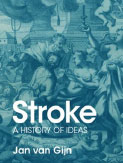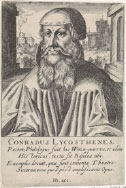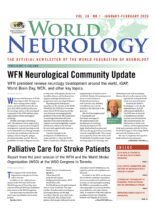A book review of the history of cerebrovascular disorders.
Jan van Gijn. Cambridge University Press, 2023.
By Jan Stam
 Jan van Gijn hardly needs an introduction. He is well known for his clinical research of cerebrovascular disorders. He chaired the Utrecht team that made many contributions to our knowledge of different types of stroke, notably transient ischemic attacks and aneurysmal subarachnoid hemorrhage. Many participants of stroke conferences will remember his well-designed presentations, often illustrated with paintings by Dutch masters.
Jan van Gijn hardly needs an introduction. He is well known for his clinical research of cerebrovascular disorders. He chaired the Utrecht team that made many contributions to our knowledge of different types of stroke, notably transient ischemic attacks and aneurysmal subarachnoid hemorrhage. Many participants of stroke conferences will remember his well-designed presentations, often illustrated with paintings by Dutch masters.
In September 2023, a Dutch national newspaper featured a long interview with Van Gijn. The occasion was his recently published book: Stroke. A History of Ideas. After his retirement, Van Gijn continued to study cerebrovascular diseases, but now mainly in the role of an historian of science, a career switch that resulted in this impressive monograph.
 In the foreword, the author mentions some pitfalls for amateurs who write about the history of their own profession. One is consulting secondary, translated, and often unreliable sources. A second is known as presentism, the fallacy to reconstruct history, looking back from the vantage point of today’s knowledge, as a rational process that leads in a straight line, through a sequence of major discoveries to the present. Van Gijn has avoided these pitfalls by thorough preparation. He studied Latin and enrolled as a student of history and philosophy of science.
In the foreword, the author mentions some pitfalls for amateurs who write about the history of their own profession. One is consulting secondary, translated, and often unreliable sources. A second is known as presentism, the fallacy to reconstruct history, looking back from the vantage point of today’s knowledge, as a rational process that leads in a straight line, through a sequence of major discoveries to the present. Van Gijn has avoided these pitfalls by thorough preparation. He studied Latin and enrolled as a student of history and philosophy of science.
The story begins with descriptions “fap’plexy” by Galen and other authors of Greco-Roman antiquity, followed by a brief overview of medieval thinking, which mainly recycled or paraphrased antique ideas, embedded in the then-dominant religious worldviews. The modern era starts about halfway in the 16th century with what is often called the medical renaissance.
During the 16th century, the ancient dogmas slowly made way for personal observations (“auto-opsia”) and insights, with the anatomist Andreas Vesalius (1514-1564) as one of the iconic innovators. Theories about the role of the ventricles as the site or origin of a neural signaling substance (such as Descartes’ esprits animaux) or mental activity became obsolete, and the function of the circulatory system was slowly revealed. The era covered in the book ends in 1975, with a picture of the first CT scan showing a large pixeled image of a cerebral hemorrhage.
Numerous clinical case histories, often translated from Latin by the author, increasingly large series of published autopsies, and finally the first prospective studies and trials, show how the ideas about stroke gradually changed. One of the first clinical observations was by Conrad Wolffhart (Lycosthenes; 1518-1561). He recovered from his own apoplexy and was able to give a careful description: “I not only lost my voice, but also all sensation and movement of the right side, from head to heel (except sight and hearing)”. During his long recovery, he could communicate with his friends by pointing with his left index finger to the letters which were written on a slate in alphabetical order. He finally recovered almost completely, a miracle for which he thanked “God almighty in the first place, and thereafter Dr. Gratoloro”. Van Gijn added a beautiful etching of Lycosthenes from the Rijksmuseum, Amsterdam, one of the many historical images that accompany the text.
As more causes of acute cerebral disorders were identified, the concept of apoplexy became diluted and could refer to about any kind of sudden cerebral dysfunction, by whatever cause, or spontaneously. Around 1800, more than 20 variants were distinguished, including nervous, traumatic, lymphatic, and abdominal apoplexy, orderly summarized in a table in a French treatise published in 1811. Autopsy findings often did not help, due to endless confusion about the nature and causes of brain softening (“ramollisement,” Chapter 6) and of infection and inflammation, which lasted until the mid-19th century. Chapter 7 describes the clarification of thrombosis and embolism as causes of brain softening, based upon the work of Rudolf Virchow (1821-1902) and others. The developing insights in the role of atherosclerotic changes of the carotid arteries are described in Chapter 8,
including the discussion about the contribution of obstructed blood flow versus artery-to-artery embolism. The last four chapters discuss lacunae, transient ischemic attacks, subarachnoid hemorrhage, and sinus thrombosis. The increasingly important contributions of technological innovations, such as microscopy and the use of X-rays to the understanding the different kinds of stroke are given its due place in the final chapters.
As we approach the year 1975, prevention and treatment, both surgical and medical slowly enter the scene. A background theme discernible throughout the book is Van Gijn’s bibliophilia. Beautiful illustrations, often copied from his own library, enliven the text, with interesting footnotes about illustrators and graphic techniques.
Additional historical context is presented in 43 boxes with short, highly readable, and often witty biographies of some prominent figures, such as Vesalius, Variolo, Wepfer, Willis, Virchow, Boerhaave, Charcot, Gowers, and Miller Fisher. Lesser-known physicians who contributed to the knowledge of stroke are also honored, such as Charles le Pois (1563-1633), who, perhaps not coincidentally, received the smallest box. Interesting asides enrich these brief portraits and show how these scholars were often active outside their medical practices or the autopsy theatre. Both Virchow and Egas Moniz (1874-1955) for instance were prominent national politicians. The first had severe disagreements with the Prussian Chancellor von Bismarck, apparently a risky position since he barely escaped a duel. Egas Moniz, known for introducing frontal leukotomy (honored with the Nobel prize in 1949) and for pioneering cerebral angiography, was imprisoned for republican activism when he studied medicine and later became a member of parliament, ambassador, and minister of foreign affairs.
Box 2.3 is dedicated to the Swiss physician and scholar Johann Jakob Wepfer (1620-1695). He was a vigorous proponent of post-mortem dissection, including of his own body after his death. In 1658, he was the first to carefully describe cases of apoplexy without apparent cause, which showed a hemorrhage in the brain at autopsy. He proposed that a rupture of an artery was the cause of the hemorrhage, agreeing with William Harvey’s (1578-1657) theory of the circulation that was published 30 years before but still controversial. Wepfer acknowledged the senate of Schaffhausen for the permission to do post-mortem examinations and denounced those who, “led by whatever religion, maliciously proclaim that any corpse must be buried intact, while they themselves are destined to become food for the worms.”
Wepfer’s name is linked to the yearly award by the European Stroke Conference for outstanding researchers. Jan van Gijn was honored with the Wepfer award in 2010 for his many contributions to the clinical science of cerebrovascular disorders. In the laudation, Peter Sandercock called him a “renaissance man” because of his multifaceted interests and knowledge. The publication of this book confirms that reputation. If a chapter with recent developments were ever added, Van Gijn would have to dedicate a box to himself. This must be one of the good reasons for the author to end the story in 1975.
The subtitle — a history of ideas — is explained in the final paragraph of the last chapter, on cerebral sinus thrombosis. After discussing the various concepts covered by the term pseudotumor cerebri, Van Gijn observes: “… names of diseases do not refer to entities that exist by themselves. They only stand for ideas.”
Obviously, the book is much more than a history of mere ideas. To paraphrase Immanuel Kant: ideas without observations are empty, observations without ideas are blind. Ideas about stroke have been proposed, rejected, corrected, and developed through clinical observations, autopsies, technological innovations, microscopic and radiological research, and experiments.
This book provides a splendid insight into that process. It will be a standard reference about the history of stroke for many years to come, both for historians of medical science and for doctors interested in the history of neurology. •
Jan Stam is emeritus professor of Neurology, Amsterdam University Medical Centre, the Netherlands.
